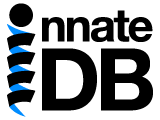| Homo sapiens Protein: SOX10 | |||||||||||||||||||||||
|---|---|---|---|---|---|---|---|---|---|---|---|---|---|---|---|---|---|---|---|---|---|---|---|
| Summary | |||||||||||||||||||||||
| InnateDB Protein | IDBP-7214.6 | ||||||||||||||||||||||
| Last Modified | 2014-10-13 [Report errors or provide feedback] | ||||||||||||||||||||||
| Gene Symbol | SOX10 | ||||||||||||||||||||||
| Protein Name | SRY (sex determining region Y)-box 10 | ||||||||||||||||||||||
| Synonyms | DOM; PCWH; WS2E; WS4; WS4C; | ||||||||||||||||||||||
| Species | Homo sapiens | ||||||||||||||||||||||
| Ensembl Protein | ENSP00000354130 | ||||||||||||||||||||||
| InnateDB Gene | IDBG-7212 (SOX10) | ||||||||||||||||||||||
| Protein Structure |

|
||||||||||||||||||||||
| UniProt Annotation | |||||||||||||||||||||||
| Function | Transcription factor that seems to function synergistically with the POU domain protein TST-1/OCT6/SCIP. Could confer cell specificity to the function of other transcription factors in developing and mature glia (By similarity). {ECO:0000250}. | ||||||||||||||||||||||
| Subcellular Localization | Cytoplasm. Nucleus. | ||||||||||||||||||||||
| Disease Associations | Waardenburg syndrome 2E (WS2E) [MIM:611584]: An autosomal dominant auditory-pigmentary disorder characterized by sensorineural deafness, pigmentary disturbances of the hair, skin and eyes, and absence of dystopia canthorum which is the lateral displacement of the inner canthus of each eye. Individuals with WS2E may have neurologic abnormalities, including mental impairment, myelination defects, and ataxia. Some patients can manifest features of Kallmann syndrome. {ECO:0000269PubMed:10441344, ECO:0000269PubMed:17999358, ECO:0000269PubMed:21898658}. Note=The disease is caused by mutations affecting the gene represented in this entry.Waardenburg syndrome 4C (WS4C) [MIM:613266]: A disorder characterized by the association of Waardenburg features (depigmentation and deafness) with the absence of enteric ganglia in the distal part of the intestine (Hirschsprung disease). {ECO:0000269PubMed:18348274, ECO:0000269PubMed:21898658, ECO:0000269PubMed:9462749}. Note=The disease is caused by mutations affecting the gene represented in this entry.Peripheral demyelinating neuropathy, central dysmyelinating leukodystrophy, Waardenburg syndrome and Hirschsprung disease (PCWH) [MIM:609136]: A complex neurocristopathy that includes features of 4 distinct syndromes: peripheral demyelinating neuropathy, central dysmyelinating leukodystrophy, Waardenburg syndrome and Hirschsprung disease. {ECO:0000269PubMed:10762540, ECO:0000269PubMed:15004559, ECO:0000269PubMed:19208381, ECO:0000269PubMed:21898658}. Note=The disease is caused by mutations affecting the gene represented in this entry. | ||||||||||||||||||||||
| Tissue Specificity | Expressed in fetal brain and in adult brain, heart, small intestine and colon. | ||||||||||||||||||||||
| Comments | |||||||||||||||||||||||
| Interactions | |||||||||||||||||||||||
| Number of Interactions |
This gene and/or its encoded proteins are associated with 15 experimentally validated interaction(s) in this database.
They are also associated with 2 interaction(s) predicted by orthology.
|
||||||||||||||||||||||
| Gene Ontology | |||||||||||||||||||||||
Molecular Function |
|
||||||||||||||||||||||
| Biological Process |
|
||||||||||||||||||||||
| Cellular Component |
|
||||||||||||||||||||||
| Protein Structure and Domains | |||||||||||||||||||||||
| PDB ID | |||||||||||||||||||||||
| InterPro |
IPR009071
High mobility group box domain IPR022151 Sox developmental protein N-terminal |
||||||||||||||||||||||
| PFAM |
PF00505
PF09011 PF12444 |
||||||||||||||||||||||
| PRINTS | |||||||||||||||||||||||
| PIRSF | |||||||||||||||||||||||
| SMART |
SM00398
|
||||||||||||||||||||||
| TIGRFAMs | |||||||||||||||||||||||
| Post-translational Modifications | |||||||||||||||||||||||
| Modification | |||||||||||||||||||||||
| Cross-References | |||||||||||||||||||||||
| SwissProt | P56693 | ||||||||||||||||||||||
| PhosphoSite | PhosphoSite-P56693 | ||||||||||||||||||||||
| TrEMBL | A6PVD3 | ||||||||||||||||||||||
| UniProt Splice Variant | |||||||||||||||||||||||
| Entrez Gene | 6663 | ||||||||||||||||||||||
| UniGene | Hs.376984 | ||||||||||||||||||||||
| RefSeq | |||||||||||||||||||||||
| HUGO | HGNC:11190 | ||||||||||||||||||||||
| OMIM | 602229 | ||||||||||||||||||||||
| CCDS | CCDS13964 | ||||||||||||||||||||||
| HPRD | 03752 | ||||||||||||||||||||||
| IMGT | |||||||||||||||||||||||
| EMBL | AJ001183 AK300945 AL031587 BC002824 BC007595 BT020029 CH471095 CR456584 CR536571 | ||||||||||||||||||||||
| GenPept | AAH02824 AAH07595 AAV38832 BAG62574 CAA04576 CAB62982 CAG30470 CAG38808 EAW60204 EAW60205 | ||||||||||||||||||||||
